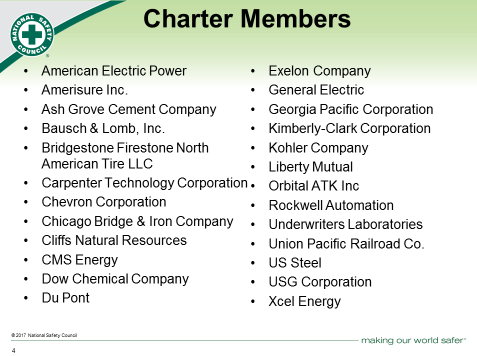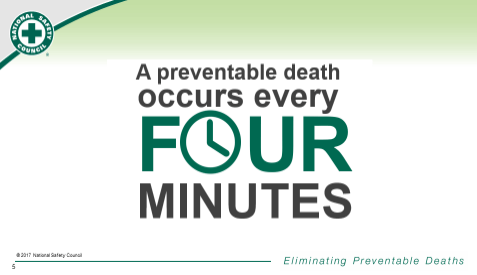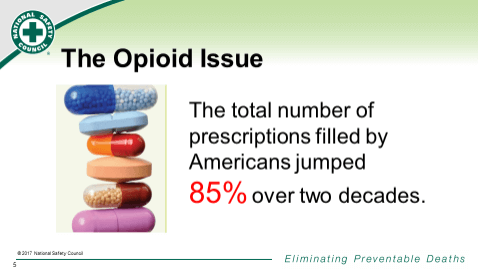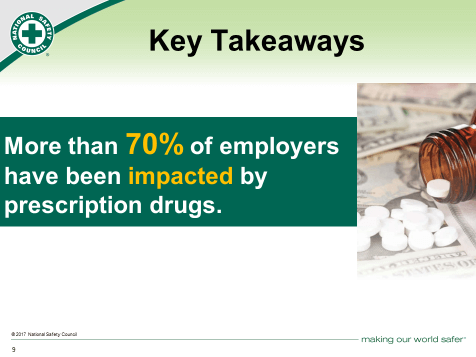More than 70% of employers have felt the impact of prescription drug use.
Encouragingly, 70% would also like to help employees who are struggling with prescription drug misuse return to their positions after successfully completing treatment.
The problem has become widespread.
39% have experienced employees taking prescription pain relievers at work – and 39% have noticed absenteeism for that reason.
1 in 10 have employees who have been arrested or overdosed due to prescription drugs.
According to the Federal Reserve ‘Beige book,’ the results of the opioid impact on the American workforce have been dire. Factories can’t find qualified workers. Federal Reserve Chairwoman Janet Yellen testified in July that hiring is down because of the opioid crisis.
The misuse or abuse of prescription medication can affect productivity or contribute to errors and make workplaces more dangerous to the people working there.
It should come as no surprise that 15% of respondents have seen instances of a near miss or an injury attributable to prescription medication misuse or abuse.
Keep in mind: these results only capture incidents where employers knew that prescription drug use contributed to the incident or near-incident. How many times has a situation occurred but supervisors did not know about the correlation?
Despite 70% saying they have been impacted by prescription drug misuse, one in four employers say they feel extremely unprepared to deal with this issue.
Not surprisingly, larger organizations are more likely to feel prepared to handle prescription misuse.
An ounce of prevention is worth a pound of cure. We cannot wait until after an incident occurs to do something about it. Taking proactive, proven measures not only saves lives and prevent injuries, but keep costs down and morale higher.
We found that 76 percent do not offer training to help employees spot signs of misuse.
Not surprisingly, 4 in 10 employers are not confident that individual employees can spot warning signs of prescription drug misuse. These are the people who are working side-by-side with individuals who may be suffering from a substance use disorder. They are the people who, if trained to do so, have the best chance of spotting warning signs.
But it’s not just the employees, around 1 in 4 are not confident that managers or supervisors can spot signs, either.
Unlike excessive misuse of alcohol, prescription drug misuse is not always easy to identify, which is why training needs to be comprehensive and available to all employees – not just managers and supervisors.
Training has costs, yes, but those costs are offset by the safety and productivity benefits.
And here’s where the data get really interesting. Many have not embraced that addiction is a disease – not a decision. So while it is encouraging to see many employers recognize that people who struggle with prescription drug misuse need treatment, just as they would if they were battling diabetes or cancer, 65% still feel the issue is a justifiable reason to terminate. This does not mean that employers will fire an employee. But it does signal a need for better education about the nature of addiction and options for successful treatment.
The good news is that 70% of employers would like to help employees who struggle with prescription drug misuse.
The most common response is to return people to work after treatment. This was a critical finding, because research clearly shows that people are likely to stick with employer-initiated treatment.
So how are employers addressing opioids in the workplace?
We asked HR managers about their workplace policies, and found that 81 percent of respondents’ policies are lacking at least one critical element of an effective drug-free workplace program.
Drug testing is the most likely element to be covered by employer policies, and it is an important one. However, that’s just one element.
A lot of times, people don’t understand that when it says do not operate heavy machinery on your medicine, that means you shouldn’t be driving a car. This has an impact for employer return to work policies. And may mean employers may need to help accommodate workers who are recovering from an injury so they can work from home.
Look at medical marijuana. We have 50% living in a state that’s either decriminalized, or passed medical or recreational use, and the issue is something I know many employers are concerned about. Yet most companies don’t have a policy with regard to marijuana.
16% of respondents told us they are either not confident – or simply do not know – whether they have appropriate policies or benefit programs in place for dealing with prescription drug misuse.
The best workplace policies must both proactively and reactively address opioid use, and should be comprehensive.
Even for employers who have drug testing policies, only 57% drug test, and an even smaller fraction are testing for synthetic opioids.
At NSC we took steps to reassess our own policies because our testing did not include opioids. We were surprised to learn that adding opioids, going from a six-panel to a 12-panel, carried no additional cost.
The reality is that many companies, in their testing protocols, follow the federally regulated drug testing program, and this program has been insufficient in the past because it has not included opioid painkillers.
The good news is that the federal drug testing program added opioid painkillers to its drug testing panel last year. It is our hope that this will become the new industry standard.
We found that 88% are interested in their insurer covering alternative pain relief treatment so employees do not need to take opioids.
Common alternative treatments include physical therapy, acupuncture, massage, cognitive behavioral therapy, mindfulness, meditation, yoga and Tai Chi.
In fact, the American College of Physicians recently issued guidelines for treating lower back pain, and they advise using alternative treatments with prescription drugs as a last resort.
Not only that, but studies have found that over the counter meds like Tylenol and Ibuprofen are actually much more effective pain relievers than oxycodone. And they are far cheaper!
I took my 16 year old son to get his wisdom teeth out, and a 6 day supply of painkillers was $140. After insurance, that cost me $40, but just $14 could have purchased a month supply of over the counter medicines that are just as if not MORE effective as pain relievers, without the dangers of dependence. Using opioids as a last resort is a triple win in the cost and benefit analysis.
Let me share one success story. Texas began requiring pre-authorization in workers’ comp cases for certain drugs not recommended for injured workers, including 25 different types of opioids, and saw a dramatic 74% drop in those prescriptions in new cases as well as cost savings of $3.6 million in just one year.
The state took pains to apply evidence-based guidelines to treat workers, and allowed time for patients and their physicians to adjust to the new rules.
Most employers want to reduce harm, and increase productivity.
But the biggest reason employers should care about the issue is out of concern for their employees. Research indicates that those struggling with a substance use disorder have better sustained recovery rates if their employers initiate and monitor their treatment than if that treatment is initiated by friends or family. Employers make a huge difference.
Research tells us that 1 in 3 people have been directly impacted by opioids, the most fatal drug crisis in recorded history. Knowledge is our best defense.
Our next speaker understands the importance of being informed.
Eric Goplerud is the vice president at NORC at the University of Chicago.
Based on the results of this survey, we worked with NORC and Shatterproof to develop a tool to help employers understand the costs of opioid use in the workplace. Eric will share this tool with you now.




